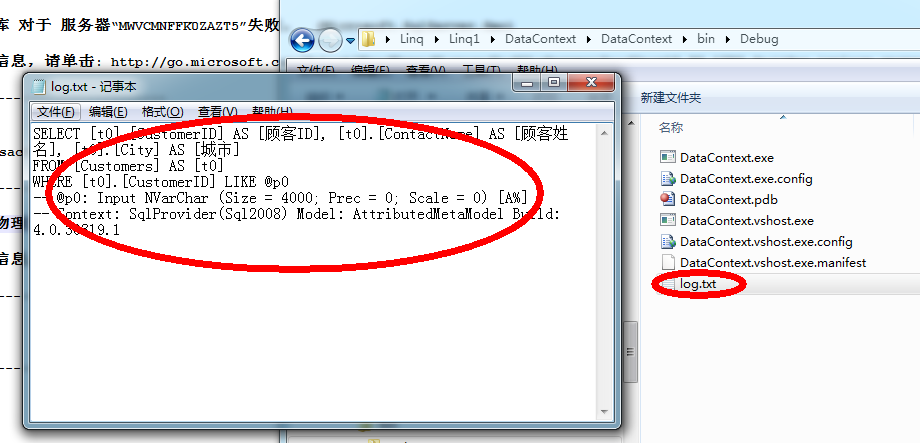一步一步学Linq to sql(二):DataContext与实体
DataContext
DataContext类型(数据上下文)是System.Data.Linq命名空间下的重要类型,用于把查询句法翻译成SQL语句,以及把数据从数据库返回给调用方和把实体的修改写入数据库。
DataContext提供了以下一些使用的功能:
以日志形式记录DataContext生成的SQL
执行SQL(包括查询和更新语句)
创建和删除数据库
DataContext是实体和数据库之间的桥梁,那么首先我们需要定义映射到数据表的实体。
定义实体类
using System;using System.Collections.Generic;using System.Linq;using System.Text;using System.Data.Linq.Mapping;namespace DataContext{ [Table(Name = "Customers")] public class Customer { [Column(IsPrimaryKey = true)] public string CustomerID { get; set; } [Column(Name = "ContactName")] public string Name { get; set; } [Column] public string City { get; set; } }} |
以Northwind数据库为例,上述Customers类被映射成一个表,对应数据库中的 Customers表。然后在类型中定义了三个属性,对应表中的三个字段。其中,CustomerID字段是主键,如果没有指定Column特性的Name属性,那么系统会把属性名作为数据表的字段名,也就是说实体类的属性名就需要和数据表中的字段名一致。
///DataContext<br> DataContext ctx = new DataContext(ConfigurationManager.ConnectionStrings["ConnString"].ConnectionString);<br> Table<Customer> Customers = ctx.GetTable<Customer>();<br> var Cus=from c in Customers <br> where c.CustomerID.StartsWith("A") <br> select new {顾客ID=c.CustomerID, 顾客名=c.Name, 城市=c.City};<br> foreach (var ct in Cus.ToList())<br> {<br> Console.WriteLine("姓名为:{0}在城市{1}",ct.顾客名,ct.城市);<br> } |
使用DataContext类型把实体类和数据库中的数据进行关联。你可以直接在DataContext的构造方法中定义连接字符串,也可以使用IDbConnection:
IDbConnection conn = new SqlConnection(ConfigurationManager.ConnectionStrings["ConnString"].ConnectionString);DataContext dc= new DataContext(conn);Customers = dc.GetTable<Customer>(); |
结果显示如下

强类型DataContext
namespace DataContextTest{ public partial class NorthWindDataContext: DataContext { public Table<Customer> Customers; public NorthWindDataContext(IDbConnection connection):base(connection) { } public NorthWindDataContext(string connection) : base(connection) { } }} |
强类型数据上下文使代码更简洁:
///强类型DataContextNorthWindDataContext NWDC = new NorthWindDataContext(ConfigurationManager.ConnectionStrings["ConnString"].ConnectionString);var NWCustomers = from NWs in NWDC.Customers where NWs.CustomerID.StartsWith("A") select new { 顾客ID = NWs.CustomerID, 顾客姓名 = NWs.Name, 城市 = NWs.City };foreach (var cst in NWCustomers.ToList()){ Console.WriteLine("姓名为:{0}在城市{1}", cst.顾客姓名, cst.城市);} |
DataContext其实封装了很多实用的功能,下面一一介绍。
日志功能
//日志功能NorthWindDataContext NWDC = new NorthWindDataContext(ConfigurationManager.ConnectionStrings["ConnString"].ConnectionString);StreamWriter sw = new StreamWriter("log.txt", true); // AppendNWDC.Log = sw;var NWCustomers = from NWs in NWDC.Customers where NWs.CustomerID.StartsWith("A") select new { 顾客ID = NWs.CustomerID, 顾客姓名 = NWs.Name, 城市 = NWs.City };foreach (var cst in NWCustomers.ToList()){ Console.WriteLine("姓名为:{0}在城市{1}", cst.顾客姓名, cst.城市);}sw.Close(); |
运行程序后在目录生成了log.txt,每次查询都会把诸如下面的日志追加到文本文件中:

应该说这样的日志对于调试程序是非常有帮助的。
探究查询
///探究查询NorthWindDataContext ctxc = new NorthWindDataContext(ConfigurationManager.ConnectionStrings["ConnString"].ConnectionString);var select = from cc in ctxc.Customers where cc.CustomerID.StartsWith("A") select new { 顾客ID = cc.CustomerID, 顾客名 = cc.Name, 城市 = cc.City };DbCommand cmd = ctxc.GetCommand(select);Console.WriteLine(cmd.CommandText);foreach (DbParameter parm in cmd.Parameters) Console.WriteLine(string.Format("参数名:{0},参数值:{1}", parm.ParameterName, parm.Value));Customer customer = ctxc.Customers.First(); ///修改第一条记录customer.Name = "aehyok";IList<object> queryText = ctxc.GetChangeSet().Updates;Console.WriteLine(((Customer)queryText[0]).Name); |
在这里,我们通过DataContext的GetCommand方法获取了查询对应的DbCommand,并且输出了CommandText和所有的DbParameter。之后,我们又通过GetChangeSet方法获取了修改后的实体,并输出了修改内容。
执行查询
///执行查询NorthWindDataContext ctx = new NorthWindDataContext(ConfigurationManager.ConnectionStrings["ConnString"].ConnectionString);string newcity = "Shanghai";ctx.ExecuteCommand("update Customers set City={0} where CustomerID like 'A%'", newcity);IEnumerable<Customer> customers = ctx.ExecuteQuery<Customer>("select * from Customers where CustomerID like 'A%'");foreach (var ct in customers){ Console.WriteLine("姓名为:{0}在城市{1}", ct.Name, ct.City);} |
前一篇文章已经说了,虽然Linq to sql能实现90%以上的TSQL功能。但是不可否认,对于复杂的查询,使用TSQL能获得更好的效率。因此,DataContext类型也提供了执行SQL语句的能力。代码的执行结果如下图:

创建数据库
[Table(Name = "test")]public class test{ [Column(IsPrimaryKey = true, IsDbGenerated = true)] public int ID { get; set; } [Column(DbType = "varchar(20)")] public string Name { get; set; }}public partial class testContext : DataContext{ public Table<test> test; public testContext(string connection) : base(connection) { }} ///创建数据库 Console.WriteLine("创建数据库"); testContext ctx = new testContext(ConfigurationManager.ConnectionStrings["ConnStringTest"].ConnectionString); ctx.CreateDatabase(); |
段代码在数据库中创建了名为NorthwindTest的数据库,因为我在配置文件中创建的如下字符串连接
<add name="ConnStringTest" connectionString="server=.;database=NorthwindTest;uid=sa;pwd=saa"/> |
那么以及test数据库表也会一同被创建。同时,DataContext还提供了DeleteDatabase()方法,在这里就不列举了。
使用DbDataReader数据源
///使用DbDataReader数据源var conn = new SqlConnection(ConfigurationManager.ConnectionStrings["ConnString"].ConnectionString);var ctx = new DataContext(conn);var cmd = new SqlCommand("select * from customers where CustomerID like 'A%'", conn);conn.Open();var reader = cmd.ExecuteReader();var Recorders = ctx.Translate<Customer>(reader);foreach (var cus in Recorders){ Console.WriteLine("姓名为{0}城市为{1}",cus.Name,cus.City);}conn.Close(); |
你同样可以选择使用DataReader获取数据,增加了灵活性的同时也增加了性
总结
看到这里,你可能会觉得手工定义和数据库中表对应的实体类很麻烦,不用担心,VS提供了自动生成实体类以及关系的工具,工具的使用将在以后讲解。今天就讲到这里,和DataContext相关的事务、加载选项、并发选项以及关系实体等高级内容也将在以后讲解。




【推荐】编程新体验,更懂你的AI,立即体验豆包MarsCode编程助手
【推荐】凌霞软件回馈社区,博客园 & 1Panel & Halo 联合会员上线
【推荐】抖音旗下AI助手豆包,你的智能百科全书,全免费不限次数
【推荐】轻量又高性能的 SSH 工具 IShell:AI 加持,快人一步
· 智能桌面机器人:用.NET IoT库控制舵机并多方法播放表情
· Linux glibc自带哈希表的用例及性能测试
· 深入理解 Mybatis 分库分表执行原理
· 如何打造一个高并发系统?
· .NET Core GC压缩(compact_phase)底层原理浅谈
· 手把手教你在本地部署DeepSeek R1,搭建web-ui ,建议收藏!
· 新年开篇:在本地部署DeepSeek大模型实现联网增强的AI应用
· Janus Pro:DeepSeek 开源革新,多模态 AI 的未来
· 互联网不景气了那就玩玩嵌入式吧,用纯.NET开发并制作一个智能桌面机器人(三):用.NET IoT库
· 【非技术】说说2024年我都干了些啥